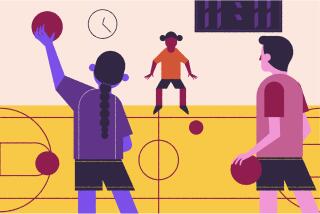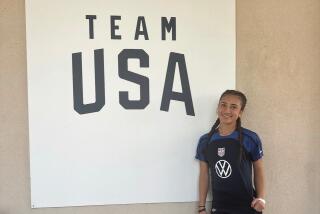For Women, Itâs a Whole New Ballgame
Wayne Thobe grew up in a family in which his three athletic brothers received college basketball scholarships.
Now Thobeâs son is a wrestler at Mater Dei High, and his daughter is a junior high softball player. And basketball player. And thinking about trying some other sports too.
Who can blame her for keeping her options open?
By the time 12-year-old Elaine Thobe is ready for college, she will have a smorgasbord of sporting opportunities to choose from. Scholarships will be available in sports such as rowing, soccer, water polo, field hockey and lacrosse, as well as the more traditional basketball and volleyball.
But her 15-year-old brother, Bradley, has decided not to pursue a scholarship in wrestling, a sport with few scholarships because programs are disappearing all over the country.
âItâs certainly different than when I was growing up,â said Wayne Thobe, a medical consultant who lives in Irvine. âThereâs so many chances for her, and it seems like those opportunities [for girls] will just keep on growing.â
The evolution has been spurred by Title IX, a 25-year-old federal law that required universities to provide equal athletic resources for men and women.
Slowly, that ruling has changed college sports, particularly by increasing the number of womenâs sports and athletic scholarships. But as students and their parents sort out college options for the next millennium, they will find not only an explosion of new sports for women such as rowing and water polo, but a scarcity of traditional menâs sports such as wrestling, gymnastics, even baseball.
Donna Lopiano, president of the Womenâs Sports Foundation, finds the future for women athletes at every level--professional, Olympic, collegiate, recreational--âastounding. There is so much going on that itâs hard to begin to predict the future.â
âThe numbers we are seeing are very pleasing,â Lopiano said. âBut there is still plenty of room for improvement, and I think weâll continue to see more.â
At USC next year, there will be 20 scholarships available for female rowers. This year there are five. Five years ago, rowing wasnât even a scholarship sport there.
At UC Irvine, rowing isnât a scholarship sport but it is fully sponsored by the university.
âTwo years ago we were barely competing and now we have a varsity eight, a junior varsity eight and a novice eight,â womenâs Coach Carrie Parsons says. âIn 1995 we had 14 girls on the team. This year we have 41. The sky is the limit.â
7.71 Womenâs Teams Per School, on Average
Itâs the same in many more sports for women, from soccer to ice hockey.
In 1978, according to the Womenâs Sports Foundation, U.S. colleges and universities averaged 5.61 womenâs teams per school. By 1998, that average has gone up to 7.71 womenâs teams per school.
And, fueled by a dramatic increase the past decade in girls playing high school sports, it is expected to keep rising, according to Lopiano.
âThere are sports for women now that I never heard of growing up,â Lopiano says. âSports like rowing and water polo. With the success of Olympics sports like ice hockey and synchronized swimming, I think youâll continue to see schools adding new sports.â
In 1992, only 31.8% of NCAA Division I U.S. colleges--generally the largest universities, both in terms of students and of financial commitment to athletics--offered womenâs soccer. In 1998, 83.1% do.
The growth is as extraordinary in Divisions II and III (from 32% to 59.3% in Division II; from 66% to 87.4% in Division III, where no athletic scholarships are offered; only academic and financial need aid can be given).
âThere are more and more opportunities for women,â Lisa Love, associate athletic director and womenâs volleyball coach at USC, said, âmore diverse opportunities, more balanced, less regional.
âFor example, volleyball used to totally be a West Coast sport, but now you have very good teams out East at places like Nebraska and Penn State. Rowing used to be totally an East Coast sport, and now there are programs starting up all over the place.â
If there is a downside, it has been that, in allowing for the rise of womenâs sports, many schools are cutting menâs sports.
Because Title IX made it legally necessary for schools to move toward offering exactly the same number of competitive sporting opportunities for men and women, many schools had to add as many as five or six womenâs sports, or drop menâs sports.
It was much cheaper just to drop menâs sports, especially the so-called nonrevenue sports, which cost more to sustain than the money brought in by ticket sales or television income.
UCI cut baseball and menâs track in 1992. UCLA dropped nationally respected programs in wrestling and menâs rowing.
Even today, UCI Athletic Director Dan Guerrero says, there are hard feelings among alumni about the loss of baseball. But out of that discord has come new opportunities for women.
âYouâve seen the emergence, the explosion almost, of certain sports for women,â Guerrero says. âOne that comes to mind is soccer. In the last five to 10 years it has been amazing to see how big womenâs soccer has become.â
And how small some menâs sports are becoming.
Sixteen years ago, 383 universities, 46.1% of all the colleges in the country, offered wrestling as a sport for men. By 1997 that number had fallen to 250 universities, 24.4% of all U.S. colleges.
Indeed, since 1992 at UCI, the percentage of the athletic budget spent on menâs sports has gone from 61.8% to 46.8%. In the 1998-99 school year budget, Guerreroâs budget has $469,000 going to womenâs sports and $413,050 to the men.
Ardeshir Asgari, wrestling coach at Cal State Fullerton, sees a bleak future for his sport.
Every year, Asgari says, good, competitive programs are dropped in a cold-blooded numbers game where all that matters is that equal numbers of men and women are competing in sports.
âIt really hurts me,â Asgari says. âWe are being told that wrestling is a dying sport, but that is not true. The sport is not dying in the United States. It is being murdered.
âUCLA used to have a top-five program in the nation. All the schools around here used to have wrestling. Now, Fullerton is the only school in Southern California to offer wrestling.â
Itâs not that Asgari is against increasing opportunities for women. He just canât see the fairness of harming the men.
âI understand about equity,â Asgari says. âBut where is the fairness in telling me there is no room for them?â
Looking at the Future in a Different Way
That means a new way of planning the future for families like the Thobes.
Already, they have spent considerable money furthering Elaineâs softball dreams. She has played on traveling softball teams the past four years, which cost several thousand dollars a year.
They hope the investment will pay off in a college scholarship, though Wayne Thobe concedes that even then heâd probably only break even in his investment.
But as popular as softball has become for girls, if any sport represents the future for women, it is rowing.
According to NCAA statistics, in 1991 only 12 of 847 reporting universities offered womenâs rowing in any form, scholarship or non-scholarship. By 1997, 97 schools were offering the sport, enough to allow the NCAA to institute a national championship competition for the 1996-97 school year.
What has made rowing so attractive?
âYou can add large numbers of women, 50 to 80, in a hurry,â says Betsy Stephenson, associate athletic director at UCLA. âFor schools that have football and that have to match those football numbers, rowing is an attractive option.â
Indeed, schools are adding rowing so quickly that many are having trouble finding athletes.
Stephenson was in the athletic department at the University of Kansas when the Jayhawk program was started. âThe coaches were literally going to freshmen registration and picking girls with the right body types out of the crowd and asking them if they wanted to row,â Stephenson said.
Monica Mendez, a USC sophomore from Anaheim, did not participate in sports when she attended Mater Dei.
She arrived at USC for orientation last year as a nervous freshman eager to make friends and feel part of the university when, she said, âa girl I met said that the rowing team let anybody try out.
âI wanted to join something and be active in some way at the university, so, two weeks later, kind of just for the heck of it, I went and tried out. I had no idea, really, what rowing was. I had seen it a little on television during the Olympics but I knew nothing about it.â
Mendez found that rowers were up for 6 a.m. practices that lasted three hours, then back at the boathouse after classes for weight training and hard work on rowing machines for several hours.
Oh, yes, Mendez found out something else.
âI absolutely love this sport,â she said. âAnd I love competing and being on a team. Being in sports has taught me to budget my time better, to be better prepared, to be more mature.â
As USC increases the number of scholarships available, Mendez, who is rowing in the USC junior varsity eight, might be able to earn some unexpected financial aid. But that is not even a thought for Mendez.
The USC varsity four won an NCAA title last year, and just the thought of participating in the NCAA championship is enough to keep Mendez going.
Womenâs Sports Gain Credibility, Coach Says
The NCAAâs addition of so many championship competitions for sports like rowing, soccer and softball, UCIâs Coach Parsons says, has helped give credibility to the women in the eyes of men.
âSometimes men in athletic departments wouldnât understand what weâre trying to do or know anything about our sports,â Parsons says, âbut they always understand the NCAA tournament. If you have a chance to qualify for the NCAAs, your athletic director understands that.â
It is not just at the college level that womenâs participation keeps growing. The Womenâs Sports Foundation has statistics showing that high school sports participation by females is also growing.
During the 1989-90 school year, 1,858,659 girls participated in high school sports, compared with 3,398,192 boys. By the 1997-98 school year, the number of girls playing high school sports had jumped to 2,570,333, while the number of boys had grown only to 3,763,120.
In other words, the number of female high school athletes increased about 33% in just under a decade while menâs growth was 11%.
Lopiano of the Womenâs Sports Foundation, who was a pioneer in the formation of a strong womenâs athletic program at the University of Texas, says parents of little girls should pay attention to the continual increase of sporting opportunities for their daughters.
âThere are statistics that show if your daughter doesnât play sports by the age of 10, there is a less than 10% chance she will be a sports participant when she is 25,â Lopiano says. âAnd it is so much easier to encourage your daughters now.
âYou donât have to take them only to watch menâs sports. You can take them to a womenâs pro basketball game. You can take them to your local college or high school or to an organized league and they can watch other girls, of all ages, playing sports and having a good time. And thatâs the important thing.
âFor boys, that has always been a given. Finally, I think it might be the same for girls.â
Bradley Thobe says he doesnât resent the big, promising future that seems ahead for his sister. Wrestling for him is mainly about self-fulfillment, which isnât bad, just different.
Until about five years ago, thatâs the way it was for most female athletes. They participated solely for the sheer joy of competition. Now Bradley says thatâs why he wrestles.
âThatâs whatâs important to me,â he says.
(BEGIN TEXT OF INFOBOX / INFOGRAPHIC)
About the Series
Beyond 2000 is a series of articles that explore how our lives will change in the next millennium. The series will continue every Monday through the end of 1998 as The Times Orange County examines whatâs in store for the county in such areas as transportation, education, growth and technology.
On the Internet
The Beyond 2000 series and an interactive discussion are available on the Times Orange County Editionâs Web site at https://www.timesoc.com/HOME/NEWS/ORANGE/beyond.htm
Launch Point 2000
More information on todayâs topic can be found on several Web sites:
Sports Century: Who were the most important sports figures of this century? Find out through this site that features a new athlete profile daily as well as a key moment in sports history.
https://ESPN.SportsZone.com/sportscentury/index.html
Women and Physical Activity: A Historical Journey: How much do you know about the history of womenâs sports? Find out through an online quiz. This site also includes helpful links to biographies of famous (and not-so-famous) sports champions as well as commentary on Title IX and current issues affecting female athletes.
https://primusweb.com/fitnesspartner/library/activity/womenhistory.htm
Just Sports for Women: How do you train for a triathlon? What is it like to be an Olympic fencer, a sports lawyer, or a sports psychologist? Keep current on whatâs new in womenâs sports through news updates and interviews with top athletes.
https://www.justwomen.com/
The Sporting News: This extensive collections of sports resources includes a scoreboard, season forecasts and recent rumors, player biographies, expert commentary and the chance to chat with other fans about your favorite sport.
https://www.sportingnews.com/
CNN/Sports Illustrated: Stay up-to-date in sports through this collection of interviews, articles, scores, photos and even video and audio clips. Find out what the experts think, check out TV schedules and try your pick of sports games and trivia.
https://www.cnnsi.com/
PE Central Sport Web Sites: Find tips, drills and resources that can help you improve your play or your coaching skills in 23 sports including basketball, volleyball, soccer, tennis and golf.
https://pe.central.vt.edu/sportsites.html
Slow Gains on the Sports Field
Forty percent of todayâs college and high school athletes are female, and many college officials anticipate those numbers will continue to increase in the next decade. More than 330,000 students participated in NCAA sports programs in 1996-97, and nearly 6.2 million boys and girls participated in high school sports.
NCAA Participation
*--*
Men Women 82-83 180,235 80,040 83-84 188.594 84,813 84-85 201,063 91,669 85-86 200,031 95,351 86-87 190,017 91,101 87-88 178,941 89,825 88-89 180,145 91,409 89-90 177,165 89,212 90-91 184,593 92,778 91-92 186,045 96,467 92-93 187,038 99,859 93-94 189,642 105,532 94-95 189,084 110,524 95-96 199,556* 123,832* 96-97 200,627* 128,209*
*--*
High School
*--*
Boys Girls 82-83 3,355 558 1,779,972 83-84 3,303,559 1,747,346 84-85 3,354,284 1,757,884 85-86 3,344,275 1,807,121 86-87 3,364,082 1,836,356 87-88 3,425,777 1,849,684 88-89 3,416,844 1,839,352 89-90 3,398,192 1,858,659 90-91 3,406,355 1,892,316 91-92 3,429,855 1,940,816 92-93 3,416,389 1,997,489 93-94 3,478,530 2,124,755 94-95 3,536,359 2,240,461 95-96 3,634,052 2,367,936 96-97 3,706,225 2,472,043 97-98 3,763,120 2,570,333
*--*
*Includes provisional members. Provisional members follow NCAA rules and compete against other NCAA member institutions.
NOTE: High school students who participated in more than one sport are counted in the same number of sports in which they participated.
Source: National Collegiate Athletic Assn.; Womenâs Sports Foundation; UC Irvine
College Sports Participation
More women play sports such as rowing, soccer and water polo that werenât popular a decade ago simply because there are more available scholarships. Those opportunities are resulting in fewer scholarship chances for men in some sports, including wrestling and gymnastics.
*--*
Women Men Softball(F) 12,606 Baseball (M) 24,332 Basketball 13,343 15,160 Cross Country 9,949 10,113 Fencing 575 731 Field Hockey 4,828 Football x 53,900 Golf 2,083 7,163 Gymnastics 1,323 457 Ice Hockey 416 3,554 Lacrosse 3,635 5,592 Rifle 481 Rowing(F)/Crew(M) 3,569 1,693 Skiing 455 504 Soccer 13,394 16,885 Squash 364 302 Swimming 8,499 7,580 Tennis 8,156 7,961 Track, indoor 12,827 15,680 Track, outdoor 15,427 19,246 Volleyball 12,122 1,053 Water Polo 365 877 Wrestling 6,385
*--*
NOTE: Totals in several sports include mixed teams.
Source: NCAA
More to Read
Get our high school sports newsletter
Prep Rally is devoted to the SoCal high school sports experience, bringing you scores, stories and a behind-the-scenes look at what makes prep sports so popular.
You may occasionally receive promotional content from the Los Angeles Times.






